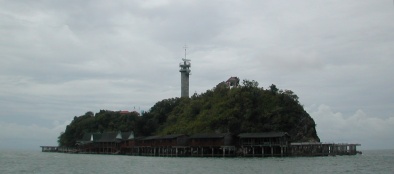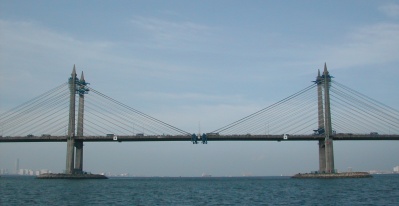SAILING IN MALAYSIA
The Malacca Strait runs along the west coast of Malaysia, and we traveled up the strait from Singapore through Malaysia to Thailand. Malacca Strait is an exceptionally busy shipping strait with 5,000 to 6,000 ships passing through each day. However, the ships are not the only danger – there are also countless surface fishing nets along much of the inshore area. This leaves precious little room for small craft.
The ships travel in charted shipping lanes a ways offshore, and they present a hazard only when they are coming in to or leaving a port. Otherwise, they stay in the shipping lanes, and small craft stay outside the lanes.
However, small craft cannot wander inshore or they will get tangled on surface fishing nets that seem to be almost everywhere. Malaysia is very heavily fished with nets within a few miles of the coast.
The only reasonable way for small craft to negotiate the strait is to travel just outside of the shipping lanes which is hopefully far enough offshore to avoid fishing nets. Many tugs/barges also travel in this area, but their numbers are reasonable, and they can be avoided.
We headed north just as the southwest monsoon was changing to a northeast monsoon. Consequently, we expected very little wind, and we planned to motor most of the way. Conventional wisdom is that this is the safest time to make this passage with the least incidence of foul weather other than the daily thunderstorms. So off we went, motoring…
We decided that we wanted to travel north in day sails (rather than overnighters) whenever possible, so we left Raffles Marina in Singapore with the intention to go only 30 miles around the southern tip of Malaysia and anchor off Pulau Pisang (the state of Johor). We immediately found ourselves in a maze of fishing nets, and we did a lot of weaving to avoid them and get further offshore and out of that danger. We immediately realized that the fishing nets would be a far greater problem than the ships on this trip.
As we rounded the bottom of Malaysia, we had 20 knots of wind directly on our nose, and the seas were steep and choppy. And, of course, we had countercurrent. This was not a pleasant way to start a trip.
But we made it to Pulau Pisang and got anchored. It was rolly and bumpy, but we decided to wait for better conditions before heading out again. That night we had a HUGE thunderstorm – Bud says it was the biggest he has ever seen. We also had torrential rains through most of the night. We probably should have been a bit uneasy, but we were both glad to be back at anchor instead of in a marina, and we enjoyed the weather.
The next morning it was still pouring, so we decided to stay put for another day. We cooked, ate, and slept away the day. We had thunderstorms and rain again that night, but they were nothing like the night before.
The following morning we left at dawn in light rain with light wind on our nose and bumpy seas. We had sails up and down, in and out, and we tried to sail at times, but we motorsailed all day.
We had an unpleasant experience with a rude fisherman who nearly rammed our boat, but he went his way after proudly exhibiting his poor manners. Otherwise, it was a slow and boring day, and we did not arrive at Pulau Besan off Malacca until after dark – something we try to avoid, especially with the abundance of nets near shore. At the end of the day, we had covered only 69 miles in almost 14 hours – an average of only 5 knots per hour. Hmm – maybe we need to clean our prop/bottom.
We awoke to thunder and rain again the next morning, so we went back to sleep for another hour. But we did get up and leave in a lighter rain by mid-morning. We were told that the busiest part of the Malacca Strait is between Malacca and Port Dickson – our planned course for the day.
There was a steady stream of ships in the shipping lanes, and there were quite a few tug/barges in various places, but it wasn’t bad at all. If this is as busy as it gets, we can do this.
We never saw the sun all day, but it was blessedly cool, and a light rain persisted. Then our engine started making a worrisome noise. It sounded like the water pump. We watched the temperature and headed toward Admiral Marina in Port Dickson (in the state of Negeri Sembilan) only 44 miles from the prior night’s anchorage where we could investigate the engine noise.
There are submerged rocks and reef near the entrance to Admiral Marina, and there is a lack of entry markers until you are nearly on the beach, so our arrival was not without a little head-scratching. But we found it ok, and were glad to be where we could check out the engine noise.
Follow us to Port Dickson or read below as we leave and head further north.
We left Port Dickson at sunrise on November 20 with plans to island hop our way up to at least Pangkor and maybe to Penang. Two other boats – SV Serenade and SV Hard Yakka – left at the same time.
We sailed a bit, motorsailed a bit, then motored. We passed the channel leading to Port Klang which is where SV Serenade and SV Hard Yakka anchored for the night. We continued up a small tributary to Pulau Ketam. Along the way, we experienced fishing nets that spanned the entire width of the channel. Our only option was to coast over them in neutral, and we somehow cleared them without snagging. Further up there was a fishing village built at last two-thirds across the channel. At least that was passable. Then we arrived at the village on Pulau Ketam. This village is built entirely on stilts over a mud flat that dries at low tide, and there are no connecting walkways. It appears that the only way to move around the village is by boat, and that is not possible at low tide. It was a charming village, and we wished we had the time to visit, but we knew that we had to keep moving after having spent so much time in Port Dickson. We left after only one night.
We decided to take it easy the next day, and we would make only a short sail to Pulau Angsa which would be our jumping off point to go to Pangkor. SV Serenade and SV Hard Yakka emerged from a parallel channel, and the three of us sailed there somewhat together.

Pulau Angsa
Pulau Angsa was a pretty little island. It has a lighthouse and a large radar station. It also has a few simple structures on the coast and a large house up near the lighthouse. The island is uninhabited other than a caretaker for the lighthouse and radar station. The caretaker was not there when we were there, and the island was deserted.
The anchorage was deeper than we like and a bit bumpy, so we decided to stay only one night. SV Serenade and SV Hard Yakka also decided to stay only one night. All three boats left at first light the following morning headed for Pangkor.
Pangkor would be a long day sail – 75 miles – so we knew we had to push all day. The three boats spread out a bit early in the day, and we barely saw each other after that – just a distant sail on the horizon. We had another long and boring motorsail, and we arrived at the southwest bay on Pangkor by just after 5:00 pm local time. SV Hard Yakka arrived shortly thereafter, and SV Serenade arrived within the next hour – all before dark.
The anchorage was again rolly, and we decided to keep moving northward. SV Serenade and SV Hard Yakka stayed behind. We sailed around Pulau Pangkor Laut which is the site of Malaysia’s most exclusive resort (reportedly a favorite of Luciano Pavoratti), then we sailed up the west coast of the island to a very pretty Teluk Belanga on the northwest tip of Pangkor. We were anchored close to a rock face, and we knew we would have to leave if the winds and/or tide swung us around, and after lunch we did leave. There is a new marina just built but not yet open about two miles south of where we were on Pulau Mentangor, so we pulled in and dropped an anchor behind their breakwall, and we had a very restful night before heading for Penang.
Penang was an 80 mile day sail, so we again had to push all day. And we again motorsailed all day. The only event of this trip was sailing under the Penang Bridge which connects Pulau Penang with the mainland. This is a suspension bridge with an air draft of 92 feet, so we cleared it easily. However, we both spent a lot of time looking up just to be certain.
Penang is also rich in Malaysian history, so we wanted to stay a few days and see the sights. We went in to Tanjong City Marina.
Follow us to Pulau Penang or read below as we leave and head further north.

Penang Bridge

Small Marlin
We left Penang with only one more stop planned in Malaysia – Langkawi. After getting out of the harbor in to open water, we actually sailed for most of the day. It was wonderful!
We also caught a marlin on this sail. It was a small blue marlin, and we only hooked his bill, so we put him back to grow up a bit. It was still nice to catch a fish – it had been a while.
We were still trying to do only day sails whenever possible, so we stopped at the first cluster of islands of Langkawi that we came to – on Pulau Tajal. To call the scenery magnificent would not do it justice. Sheer rock cliff faces rose from the clear water, and eagles soared overhead. There were a few boats scattered about the islands, but each boat had a bay to itself. We slept very well that night.
However, we had a reservation at the Telaga Harbour Marina on the main island the next day, and we felt obligated to be there since we had already changed our dates once. But reservations are hard to get this time of year, and we did not want to lose ours, so we left mid-day after only one night with the agreement that we will return here when we can.
Our trip in to the marina was an uneventful three hour motorsail during which we looked behind us more than in front. We were tied up in our berth by mid-afternoon.
We checked out of Malaysia on Langkawi, and we were underway by 11:00 am local time. Within an hour we were sailing under full main and #2 and crossed over in to Thai waters. We bid a fond farewell to Langkawi, and we planned to see it again. As it turned out, we returned to Langkawi many times.
Follow us as we sail in Thailand or jump ahead to our time in Thailand Or follow us as we return to Langkawi.